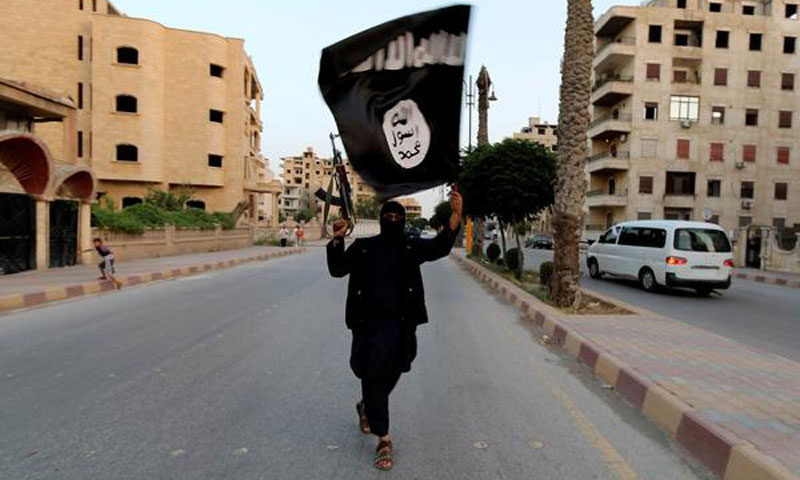



What you gain quickly, you also lose quickly. This saying also applies to the current conditions which the Islamic State Group (IS) is striving under in Syria today. The group’s sudden control over more than half of Syria in early 2014 has been met with subsequent withdrawals, in less than five months, due to military operations against it.
The fall of the city of Raqqa, the capital of the former caliphate, under the control of the Syrian Democratic Forces (SDF) in October, became the catalyst for the collapse of IS’ fronts, especially in Deir ez-Zor governorate and the areas connected to it in the eastern countryside of Homs and Hama.
Due to continuous military operations from the side of Assad’s forces and ally militias on the southern and western axes of Deir ez-Zor governorate, and other operations led by SDF and the US-led coalition on the Euphrates river’s eastern bank, IS began to retreat. According to the field map of control, the group’s control is limited to a very small space, no more than 700 square kilometers.
The city of Abu kamal, in Deir ez-Zor’s southern countryside, occupied the military scene in Syria. Assad’s forces and ally militias announced a total control over the area after the battles they started from the Syrian Badia (Syrian Desert), under the name of ‘Wa Alfajr 3′ ( And the Dawn 3), which correspond to a similar battle conducted by the Iraqi forces on the side of Al-Qa’im town.
The General Command of Assad’s forces said that the control was the outcome of cooperation between ally and reserve forces after violent battles.
However, they did not publish any photos from inside Abu Kamal neighborhoods, and the published materials were limited to video recordings of dozens of members’ attempt at progress on the city’s outskirts.
Only two days after the control announcement, IS negated Assad’s forces control over the area through a video recording published from the town’s eastern outskirts.
The video recording published by A’amaq Agency (Depths), on Saturday, November 10, shows military confrontations on the outskirts of Abu Kamal; it also said that Assad’s forces, for the third day, have failed to break into the area.
Assad’s forces failed despite the intensity of Russian and Syrian air strikes, in addition to the intensive artillery shelling amidst large losses, which included an armored personnel carrier (APC), armored vehicles and military tractors, the Agency added.
Abu Kamal is characterized by strength points, which can be invoked in any process aiming to control or maintain the city. It is considered as the second largest departmental city in the Deir ez-Zor governorate, and it is one of the first Syrian cities that went out of the Syrian regime’s control, in November 17, 2012.
IS, in 27 June 2014, controlled the city and turned it to its most important outlet to Iraq.
In conjunction with the huge military pressure facing IS in Deir ez-Zor governorate and its villages, SDF took control of the town of Markada, south of al-Hasakah, which is also the dividing point between the governorates of al-Hasakah and Deir ez-Zor.
SDF has announced its intention to break into the town of Markada, since March 2016, after it controlled Al-Shaddadah town to the north of it.
The Kurdish forces, SDF, are fighting battles in southern al-Hasakah, in conjunction with other battles against IS in Deir ez-Zor governorate, near al-Tanak oil field.
Since Thursday, November 9, attempts have been made to break into the town of al-Basira, adjacent to the Syrian regime’s control points in Deir ez-Zor, where IS have been surrounded, in addition to some of the neighboring small towns.
With its control over Markada, SDF ends the spread of IS in the final points which it has been controlling in al-Hasakah governorate.
Since October, SDF has gradually advanced in the surrounding of the town of Markada and on the outskirts of the town of Kabbar, northwest of Markada.
These military operations are part of the military campaign launched by SDF, in mid-September under the name of ‘Asifat al-Jezireh’ to take the rest of the areas in the Syrian Jezireh from the hands of IS.
Turning to the points and streets which IS controls in the southern surrounding of the capital city Damascus, which Assad’s forces keep as a justification for the internationally marketed anti-terrorism policy, IS controls vast spaces in the south of Damascus, which it calls the ‘State.’
IS’ control concentrates on the neighborhoods of al-Asali and al-Hajar al-Aswad and the two areas of Tadamon and Yarmouk Camp, which are designated for Palestinian refugees.
In the past two months, there have been repeated talks about expelling IS from the south of Damascus, in a deal with Assad’s forces. More than once the talks tackled the deal, the most notable of them is the one at the end of 2015 and the last of which was in May. However, the deal failed and IS did not leave until this day.
In the past five years, the area witnessed attack and retreat battles between the Opposition Factions and IS. The later managed to break the siege over al-Hajar al-Aswad, after it spread in Yarmouk Camp, in April 2016.
if you think the article contain wrong information or you have additional details Send Correction